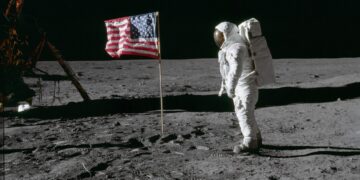Space enthusiasts, get ready for a spectacular year in 2025! With an incredible lineup of space missions ranging from moon landings to asteroid explorations and groundbreaking rocket launches, this year promises to captivate stargazers and science lovers alike. Let’s dive into the thrilling missions set to redefine our understanding of the cosmos.
The Thrill of Moon Missions
The year kicks off with a flurry of lunar missions, each promising to bring us closer to unraveling the mysteries of Earth’s nearest celestial neighbor. Firefly’s Blue Ghost lunar lander, launching in January, will carry 10 NASA payloads to the moon’s Mare Crisium impact basin. This mission aims to conduct a series of scientific experiments, providing valuable insights into lunar geology.
Japan’s Hakuto-R Mission 2 lander, scheduled for the same launch, will travel to the Mare Frigoris region, carrying a mini rover named Tenacious. Meanwhile, Intuitive Machines’ IM-2 mission will venture to the lunar south pole, exploring potential water sources that could pave the way for future human exploration. Later in the year, Blue Origin’s MK1 Lunar Lander and Astrobotic’s Griffin Mission 1 are expected to make significant strides in lunar exploration.
These missions aren’t just about science—they’re shaping humanity’s future on the moon.
SpaceX’s Starship Takes Center Stage
Starship, the largest and most powerful rocket ever built, continues to be a game-changer in space exploration. With approval for up to 25 launches in 2025, SpaceX is set to demonstrate unprecedented capabilities.
One of the highlights will be the potential docking of two Starships in orbit to test propellant transfer—a critical step for long-duration missions to Mars. Additionally, an uncrewed demonstration of the Starship Human Landing System, designed for NASA’s Artemis 3 mission, is anticipated.
A Glimpse Into the Future: Haven-1
As the International Space Station (ISS) approaches the end of its lifespan, commercial space stations are emerging as the future of low Earth orbit. In August, California-based startup Vast plans to launch Haven-1, a private space station designed to host a four-person crew for up to 30 days.
Haven-1 represents a bold step toward commercializing space. With the promise of modular expansion and innovative facilities, it offers a glimpse into a future where space tourism and private research flourish.
Juno’s Final Act
NASA’s Juno mission, which has been orbiting Jupiter since 2016, will come to a poignant end in September. After years of groundbreaking discoveries about Jupiter’s atmosphere, storms, and moons, Juno will be deorbited into the planet’s atmosphere to avoid contaminating its potentially habitable moons.
This farewell underscores the mission’s success in enhancing our understanding of the gas giant and its role in the solar system’s formation. Juno’s legacy will inspire future missions to Jupiter and beyond.
SPHEREx: Mapping the Cosmos
Launching in February, SPHEREx (Spectro-Photometer for the History of the Universe, Epoch of Reionization, and Ices Explorer) is poised to revolutionize astrophysics. This NASA observatory will perform an all-sky survey in near-infrared wavelengths, creating a 3D map of over 450 million galaxies and 100 million Milky Way stars.
SPHEREx aims to answer fundamental questions about the origins of the universe, such as how galaxies formed and how water ice influenced the development of habitable environments. Its findings will shed light on cosmic evolution and our place in the vast expanse of space.
China’s Tianwen 2 Asteroid-Sampling Mission
Building on the success of its Mars rover mission, China will launch Tianwen 2 in May. This ambitious mission will visit the near-Earth asteroid Kamo’oalewa to collect samples using cutting-edge landing and sampling technologies.
After returning these samples to Earth in 2026, the spacecraft will embark on an extended journey to study a main-belt comet.
India’s Gaganyaan Program: A Leap Toward Human Spaceflight
India’s space agency, ISRO, is making strides with its Gaganyaan program, aiming to achieve independent human spaceflight capabilities. While the first crewed flight is planned for 2026, 2025 will see critical test flights, including an uncrewed mission carrying a humanoid robot named Vyomitra.
This program highlights India’s growing prominence in space exploration and its commitment to advancing human spaceflight technology.
Flybys, New Rockets, and Ongoing Missions
Beyond these headline-grabbing missions, 2025 will be packed with other exciting events. Ongoing missions like BepiColombo (Mercury), Europa Clipper (Jupiter’s moon Europa), and Lucy (asteroids) will conduct flybys, capturing stunning images and valuable data.
New rockets, such as Rocket Lab’s Neutron, Germany’s RFA One, and China’s Zhuque-3, are set to make their debut flights, showcasing innovative technologies. Regular activities at the ISS and China’s Tiangong space station will continue to support research and international collaboration.
Why 2025 Matters for Space Exploration
The missions planned for 2025 represent a turning point in humanity’s quest to explore and understand the cosmos. They demonstrate a shift toward commercial partnerships, international collaboration, and the pursuit of ambitious goals that push the boundaries of what’s possible.
From moon landings to asteroid explorations and groundbreaking telescopes, these missions promise to deepen our knowledge of the universe, inspire future generations, and pave the way for humanity’s journey beyond Earth.
A Year to Remember
As we prepare for the adventures ahead, 2025 stands out as a year of promise and possibility. With so many groundbreaking missions on the horizon, it’s a thrilling time to be a space enthusiast. Whether you’re marveling at the ingenuity of Starship, celebrating the legacy of Juno, or dreaming of lunar colonies, the future of space exploration has never looked brighter.
So, mark your calendars and keep your eyes on the skies—2025 is going to be an extraordinary year for space exploration!



















